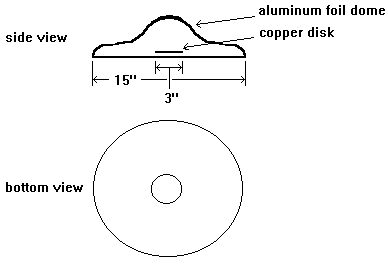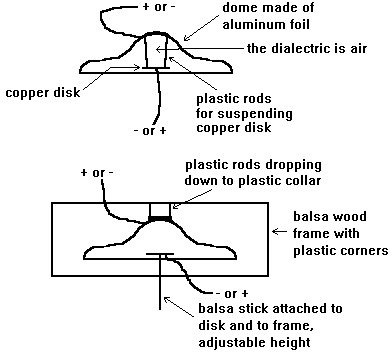The objective of this experiment was to produce a device that could lift its own weight. The initial device was to be modelled on one produced by T. Townsend Brown some time between 1956 and 1973 possibly when he was working in the Bahnson Labs. The description I have was included in a letter from Brown to Rho Sigma (not his real name) that was included in the book Ether-Technology, A Rational Approach to Gravity Control1.
T. T. Brown states in the letter that his apparatus produced an upward force of 110% of its weight. This was achieved in experiments utilizing voltages between 50 to 250 KV DC. The letter also includes a hand drawing of the device along with the basic layout of the experiment.
I work with two different shapes. One that I copied directly from that book, trying to make the dimensions exactly the same. The second shape is just a simple bowl or dome shape. The best results that I could obtain were a 30% weight loss at an estimated 150KV DC, the highest voltage my power supply can produce.
The Basic Device
The basic device consists of some dome acting as an electrode. The dome is seperated by some dialectric from another electrode, say a disk. The dome and disk are firmly attached to each other such that they move as a unit, but are electrically seperated from each other by the dialectric. The dome may be a simple bowl or a fancier double bowl as shown in these pictures. The reason for the fancier double bowl as shown here is that that is what T. T. Brown describes in his letter.
|
The following picture shows different ways of connecting the two electrodes (e.g. the dome and the disk).
|
The advantages of the second way of connecting the electrodes over the first way was that:
- there is better control over what goes in between the two electrodes,
- it is easier to change the bottom electrode as the entire bottom half of the frame was build to separate from the top half without removing the dome, thereby keeping down the wear and tear on the delicate dome,
- the distance between the two electrodes is adjustable by lowering and raising the balse stick that the copper disk is attached to.
Positive or negative voltage is applied to the dome and the opposite polarity is applied to the disk. My experiments have found that with the configurations I've tested, there is a resulting force produced in the direction of the dome (relative to the disk).
Experiments and Results from my Lab Book
I won't reproduce all the details of my lab book here but I will still give a wealth of detail starting from my first attempts to the latest.
- 1st tests - Suspending from Pulley (January 2nd and 3rd, 1998)
- 2nd tests - Suspending from Balance (January 3rd and 4th, 1998)
- 3rd tests - Hanging from a fixed thread (April 12th and 19th, 1998)
- 4th tests - Experiments using a digital scale (April 25th to June 3rd, 1998)
- 5th tests - Hanging as a Pendulum (May 9th to May 29th, 1999)



